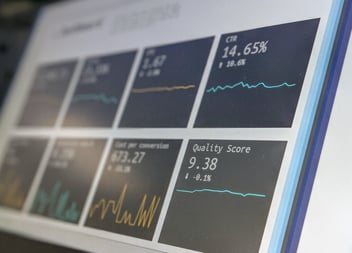Search Engine Optimisation (SEO) is a rich industry with its own concepts, language, and jargon. This glossary introduces and defines over 100 SEO terms, giving you the perfect primer to expand your SEO knowledge and help with your digital marketing efforts.
If there are any terms you think should be included, let us know and we’ll get them added.
3xx
Redirection. All 300 status codes indicate redirection, and there are several types. The ones below are most likely to be encountered.
301
Permanent redirect. The browser automatically takes you to the new page, so all you may notice is a different URL to what you were expecting. This is used in technical SEO to point to a new page when the old one has been removed or becomes redundant.
302
Temporary redirect. This is supposed to be used when developing a website or webpage, then removed afterward.
4xx
Client errors: 400 codes indicate an issue with the request from your end. The most likely you will encounter are:
403
Forbidden. If you do not have relevant permission to access the page you are requesting, you will be greeted with this error.
404
Not found. This is what you'll see if you try to navigate to a page that doesn't exist. Most websites have dedicated 404 pages that will offer you options to navigate elsewhere, but you've probably seen the default 404 page too:
Above the fold
Content which is visible on page load without having to scroll. It is assumed that content above the fold will be seen by more human users, and recommendations are therefore made to place priority content in this section.
Ahrefs
A backlink and SEO analysis platform which uses its own crawler and index to collate information about the linking structure of the internet.
Alexa Rank
A number indicating the relative amount of traffic received by a website to all other sites on the internet. The site with Alexa Rank 1 has the most visitors of any website.
Can be considered an SEO metric, although it is very rarely given precedence.
Algorithm
The rules and resulting formula used by search engines to determine their rankings. Algorithms are secret, frequently updated, and thought to be enormously complex.
Alt text
Meta data included in the HTML code of an image, which is used to give context to robots about what the image is, and by screen readers to read aloud what the image is.
Considered a requirement for a well-optimised web page.
AMP (accelerated mobile pages)
A project from Google and Twitter which aims to greatly increase page load time for AMP content. HTML code is stripped back to the bare minimum to allow quick load speed, and the AMP pages are served within Google / Twitter to further increase speed and accessibility.
Anchor text
A string of text enclosed by <a> HTML tags. A human user sees the enclosed text with visual styling to indicate that it is a clickable link.
Backlink
A hyperlink from one page to another. Links pointing to a page are considered backlinks.
Black hat
SEO techniques which are considered unethical because of the deliberate intent to improve rankings by sidestepping search engine guidelines. Often correlated with spam techniques, and often subject to penalties by search engines when techniques are identified. Updates to search engine algorithms are often made with the goal of reducing the effectiveness of such techniques.
Blog
A website or section of a website displaying individual pieces of content (called posts), usually displayed reverse-chronologically.
Blogs are distinctive in that they require ongoing content creation to function as expected, rather than other sections of websites which can have static content.
Bot
See Robot
Bounce rate
A metric showing the ratio of people who visit your site then leave after visiting just one page. Depending on campaign goals, a high bounce rate can be considered problematic.
Breadcrumbs
Navigational links on a website that show the route taken to get from the homepage to a deeper page. Each step can be shown and clicked for easy navigation, and breadcrumbs reinforce a robot's understanding of a website's navigation structure.
Cache
A snapshot of a webpage created by search engines that is stored in their index. When you carry out a search, these snapshotted pages are searched rather than the live internet: this allows for faster searching, and while the web pages are technically slightly out of date, content that is prone to change frequently is crawled more often to keep the cache fresh.
CTA (call to action)
An element of a page designed specifically to get the user to carry out a desired action.
Actions are determined by strategic goals, and their completion is measured by conversion rate.
A CTA can be a button, a sign-up form, a link to click, or many other methods.
Canonical
An HTML element which designates the preferred (canonical) version of a web page.
The canonical element helps webmasters to reduce duplicate content issues by specifying which version of a page is preferred, giving robots a better understanding of content priority.
Citation Flow
An SEO metric created by Majestic SEO to quantify the influence of a URL based on the number of sites that link to it.
Cluster content
A shorter piece of content exploring one aspect of a subject in great detail. Cluster content is linked to from a pillar page to form a topic cluster.
CMS (content management system)
Software which manages the creation and modification of online content, and which websites are often built with and supported by. Popular examples include HubSpot, WordPress, Drupal, and Joomla.
Web developers use a CMS to build websites and specific permissions can be given to other users according to their needs. Content writers can upload and edit content, for example.
Content
Information that exists on the internet. This refers to text, images, videos, product pages, guides, slideshows, and pretty much anything that a user can consume.
SEO content is content created specifically with SEO goals in mind.
Content marketing
Creation and distribution of content designed to explain, promote, and generate interest in the products and services of a business. Content can be text-based (blog posts, ebooks, whitepapers, etc) or more visual (videos, infographics, webinars).
Content marketing identifies and markets to specific audiences, with content being tailored to their needs and aligned with specific marketing goals.
Conversion
Completion of a desired action by a website user. A conversion is determined by campaign goals: it could be signing up for a newsletter, requesting a free trial, or making a purchase.
Conversion rate
The ratio of visitors who convert after visiting a webpage.
Cookie
A small file created by a website that is downloaded - either temporarily or permanently - to your computer. A cookie holds data about a person or website, and is used to keep track of users, browsing habits, and other information about a user’s session.
Crawl
The act of a search engine robot visiting and processing a website.
Robots read as much code as possible within the time they have allocated when visiting a website. They use this information to build up a picture of what the website is, what it does, how it is structured, and what content is present. This information is then used to create an entry in the search engine index.
Crawler
See Robot
CRO (conversion rate optimisation)
A system for maximising conversion rate on a website. This can be achieved by redesigning the page or page elements to make calls to action (CTAs) more prominent, or rewriting page copy, or consolidating multiple CTAs down to one.
CTR (click through rate)
A ratio showing the number of people who click a specific link compared to the number of people who viewed the webpage the link was on (or email, social media post, etc. that the link was in).
Used as a metric to determine the effectiveness of content, email campaigns, page design, and various other SEO goals.
Disavow
A method through which negative backlinks can be disassociated with a website. Google have a disavow tool which allows webmasters to report links they would like removed, and can demonstrate that they have taken active steps to do this themselves.
Links that were built maliciously by black hat SEOs might be disavowed, as can links that were built in earnest as part of earlier SEO efforts, but now fall foul of Google's guidelines.

Domain name
A text string that defines a section of the internet under administration of one authority. More commonly thought of as a website address.
Domain Authority
An SEO metric developed by Moz that takes various factors into account to predict how well a site is likely to perform in search engines. A score is awarded across a whole website from 0-100, based on factors like number of inbound links, number of linking domains, and more.
Duplicate content
Content which is copied exactly or very closely elsewhere on a website or on an external site. Duplicate content is seen as a negative SEO factor, because it offers less value than custom copy on a web page.
Some websites scrape content from other sites and publish it without their permission: duplicate content in this regard is negative, but the site where it is originally published is unlikely to be penalised if this happens out of their control.
Evergreen
A descriptor for content that is relevant and up to date, despite possibly having been published a long time ago. Evergreen content is considered desirable from an SEO perspective because up-to-date information is most likely to satisfy user search intents.
This glossary is an example of evergreen content, as it is updated occasionally to remove old terms, refine definitions, and add new terms.
Featured snippet
A special block that appears above organic results for some search queries, usually informational based. The featured snippet contains an extract of a webpage which Google feels answers the search query, along with a URL and linked page title. Indicated by the red section below:
Followed link
A link without the nofollow attribute, which vouches for and passes authority to the destination page.
Google Ads
Formerly Google AdWords
A sophisticated advertising platform where users can create and manage adverts, and distribute them amongst Google's advertising network.
Google Analytics
A service offered by Google which tracks and reports website traffic, and allows for hugely in-depth analysis of traffic, user behaviour, revenue, and more. Insights from Google Analytics are often used as the baseline for assessing the effectiveness of an SEO campaign.
Google My Business
A tool offered by Google that allows businesses to claim an online profile, which will be pulled through to search results and Google Maps search results. A Google My Business listing can be updated with photos, opening times, reviews, and much more information, and is a great way of increasing visibility and consistency of information in local searches.
Google Search Console
A free web service giving webmasters access to detailed information about the performance of their websites, and allowing them to optimise their sites' visibility.
You can check sitemaps, crawl rates, inbound and outbound links, and many more aspects of your site's performance.
Google Webmaster Guidelines
A set of official quality guidelines from Google which, when followed, will help Google to find and understand your pages, and help visitors to use your pages.
They can be found here, and we highly recommend that any SEO gets familiar.
Guest blog
A content strategy that sees an individual or organisation create content to be hosted on an external website, usually with a link back to their own. Guest blogging can be powerful if used properly but, like with many SEO techniques, it led to a proliferation of spammy blogs and thin blog content which was designed to game rankings rather than offer any value to human users.
Headings
Formatting that guides users through content on a webpage. HTML headings are ranked from h1 through to h6, with prominence allocated accordingly by crawlers. Using headings is a good way to indicate context of content on a page, and to highlight the hierarchical importance of different sections, elements, and keywords.
Homepage
The initial page of a website, where users usually start their interaction with the website. A homepage introduces a website and links to other web pages where supplementary information can be found, or other intents met (such as product pages where users can fulfil transactional intent).
HTTP status codes
A response from a server to an incoming request indicating the status of the requested page. In human terms: if you can't get to the page you've requested, these errors will tell you why.
HTTPS
The secure version of HTTP, which stands for hypertext transfer protocol. With HTTPS, information is encrypted as it is passed between computer and server, meaning that it cannot be intercepted by hackers.
Secure connection is now a ranking factor, with sites that do not use HTTPS being penalised in the rankings.
Impression
The amount of times an advert has been served through an advertising platform, not necessarily the amount of times it has been seen by a human user. Sometimes ads are served on part of a page that a human user might not scroll to.
Index
The database of websites and web pages upon which a search engine operates. Websites and pages can be added manually to an index, although much more common is automatic addition by a crawler, which scours the web for content and indexes it. If a page is not in the index of a search engine, it is not possible for it to be served in the organic results of that search engine.
Indexed
The state of a web page being added to or present in an index.
Infobox
A section of a search engine results page (SERP) which provides supplementary content to the user's query. An infobox is separate from traditional organic and paid results, and is designed with the goal of fulfilling user search intent within the search engine ecosystem, rather than requiring users to navigate away. Indicated by the red section below:
Keyword
A word or phrase deemed particularly important or relevant to the content of a website. Keywords form the basis for the functionality of search engines: users will enter queries of one or more words into search engines (via text or voice) which are designed to communicate their intent, and which search engines strive to match with relevant results as quickly as possible.
A vital part of SEO involves gaining a clear understanding of the keywords likely to be used by human users looking for information, or for a product or service. Understanding the relationship between different keywords and accompanying search intent is vital for search engines to be able to serve the correct results.
Keyword research
The practice of finding out which terms people use when looking for a product or service, and which related terms are likely to be used for closely related searches. The idea is to build a solid understanding of user behaviour and intent in a given niche, and to optimise the content on a website to be as well positioned to meet this intent as possible.
The result is web content that is tailored to real human needs, and which will likely perform better in search engines for related searches.
Tools like Google Keyword Planner, Ahrefs Keyword Explorer, and Moz Keyword Explorer can help.
Keyword stuffing
An infamous black hat SEO technique that sees an unnatural amount of keywords used in page copy to attempt to trick search engines into thinking content is more relevant than it is. Thanks to continued refinements to search engine ranking algorithms, this is one of many black hat techniques whose usefulness has fallen in recent years.
Knowledge graph
A database of knowledge used by Google to expand the range and usefulness of information served on their results pages. Information deemed relevant and useful to a user's query is presented in infoboxes alongside organic and paid listings in the search results.

Landing page
A page created specifically for one purpose, often served when a user clicks a paid listing. The idea of a landing page is to maximise the likelihood of a desired action through focused page design and a prominent call to action (CTA).
A landing page might ask a user to sign up for a free trial in exchange for their personal information, for example.
Link building
The act of deliberately building links to content on a website from external websites. Links are a longstanding factor in a search engine's determining how to rank websites, and links are often considered to vouch for the quality and usefulness of a website. More and better quality inbound links often correlates with improved rankings.
Like all SEO techniques, link building can be misused and sometimes gets a bad rap, but good links contribute to a healthy link profile, which is an important part of SEO success.
Link profile
The full set of links pointing at a website (inbound) and leading out from it (outbound). Understanding the link profile of a website shows what type of content performs well, which areas and website types consider this website a worthy resource, and various other factors.
A link profile may contain negative links which are either attracted naturally, acquired as part of a concerted black hat SEO effort, or that have fallen foul of search engine updates since they were originally built. Link profiles must be monitored and negative links removed or disavowed in order to prevent ranking penalties.
Load speed
The time taken for a page and all of its components to fully load. A long page load speed is considered to contribute to negative user experience (UX) and correlates with lower rankings as a result.
Load speed takes into account all content required to make a page interactive, whether visible (text, images, etc.) or invisible (scripts, dependencies, etc.). Tools like Google Lighthouse can provide a detailed breakdown of load speed and things that may be hindering it.
Machine learning
An aspect of artificial intelligence (AI) that allows software to learn through refining the algorithms it uses to perform a task. Search engines employ machine learning to make their algorithms more sophisticated in many ways: they are able to understand intent behind a search in greater detail; they can also understand relationships between different queries and subject areas to further increase relevance of results.
Google's RankBrain update is a great example: through machine learning, Google can take a more educated guess at what an unfamiliar word or search query means, based on an ever-increasing understanding of similar terms.
Majestic SEO
A link intelligence tool built on what they call "the world's most advanced link intelligence map". URLs can be explored along with their backlink metrics and history, and various other search intelligence metrics can be accessed.
Meta data
Information included in the header of an HTML document to give information about the contents of a web page. The most well known meta data are meta title and meta descriptions, both of which are pulled through to search engine results pages (SERPs).
Optimising meta data is often one of the first steps taken in an SEO campaign, as it provides crawlers and human users with a top-level introduction to the web page or website they are about to visit.
Mobile speed
The amount of time taken for a web page to fully load on a mobile device. Search engines place increasing importance on mobile speed, with Google having announced it as a ranking factor.
You can use tools like Google Lighthouse to test the speed of a page.
Moz
A software company founded by Rand Fishkin offering inbound marketing software and services. They are known for their suite of SEO tools and for creating various SEO metrics like Domain Authority and Page Authority.
Needs Met Rating
A rating awarded by human quality evaluators at Google, which determines how well a page meets the need(s) of a user arriving at it. There are five levels: fails to meet, slightly meets, moderately meets, highly meets, or fully meets.
The rating assesses how useful the content on a page is, how legible the content is on mobile devices, and how much supplementary information would be required to fully answer the user's query.
Nofollow
An attribute that can be added to hyperlinks to tell search engines that the link should not affect the authority of the page the link points to. A link is often considered a vouch, and is thought to be a ranking factor as a result, as more links pointing to a page could indicate it is considered useful and linkworthy.
Nofollow was created as a way for webmasters to link to content without vouching for it, and without potentially benefiting its ranking.
Noindex
A tag that can be added to the code of a webpage requesting crawlers not to index that page.
Pages that add little value to users, and which would look out of place in search results, are often no-indexed. Things like archive pages, author pages, thank you pages, login pages and admin dashboards, internal search results pages, and so on.

Organic
Refers to non-paid sections of search engine results. Improving performance in organic channels is the goal of SEO, whereas PPC and other similar disciplines look to maximise performance in paid channels. Indicated by the red section below:
Outreach
Manually contacting webmasters, content publishers, social media users or other people with the intent of getting them to share or engage with content. Outreach campaigns form a large part of content-based SEO, and are a way to seed content and attract initial engagement.
Page Authority
An SEO metric created by Moz intended to show the likelihood that an individual web page will rank. The scale is 0-100. Over 40 factors are taken into account to award a score to each page.
Page Rank
An SEO metric created by Google and named after one of its founders, Larry Page. The metric combines various factors, including number and quality of inbound and outbound links, to give a 0-10 rank to each website. Several years ago Page Rank was given very high importance by SEOs, but has since fallen out of favour.
Penalty
The negative impact on a website's performance in a search engine, either as the result of falling foul of a newly updated algorithm, or of being manually penalised by human reviewers for violation of the search engine's terms.
A calendar of Google algorithm updates can be found here.
Pillar content
The central component of a topic cluster. Pillar content gives an in-depth introduction to a broad subject, and links to smaller pieces of cluster content which give in-depth explanations of more granular aspects. Combined, they form a topic cluster.
Query
The word or words a user enters into a search engine to find the result they are looking for. Traditionally this was restricted to text, but now users can search by text, voice, or even image.
Ranking
The position of an entry in a search engine results page (SERP). Higher rankings are associated with higher visibility, click-through rate (CTR), and ROI.
Rankings used to be fixed between index refreshes, meaning a result would show up in the same position regardless of device or location. Now they change in real time depending on your search history, preferences, and device.
Referral traffic
A metric relating to the amount of visits to your site from outside of a search engine. This can track incoming traffic from email marketing, social media, and other channels.
Responsive
Design that is compatible with any device, often in real time. The idea is that device type should not restrict access to or functionality of content within websites.
Responsive design is considered a ranking factor now, which means responsive websites are prone to rank higher in search engine results.
Rich snippet
A snippet refers to the traditional method for serving a search engine result: a title, a link, and a description.
A rich snippet gives extra information to enhance the value of the snippet. Often the rich snippet pulls through information wrapped in schema mark-up.
Robot
Also called a bot, spider, or a crawler.
This is a piece of software which visits websites and explores their content and structure, before using this information to create an entry in the index of a search engine.
Access can be restricted or prohibited through use of a robots.txt file, although a bot is not obliged to obey these commands.
Robots.txt
A file uploaded to the top-level directory of your website which tells robots (crawlers, spiders, bots) which parts of your site they may access.
Access can be allowed or disallowed, allowing webmasters to curate which robots visit their site and which content they are allowed to visit.
ROI (return on investment)
This is a common KPI for evaluating SEO services, and tracks the net profit return on SEO investment. A good SEO campaign should demonstrate strong ROI.
Schema mark-up
Structured data mark-up designed to show search engines what content means, not just what it says. Special tags are wrapped around content to designate their role, allowing search engines to build a more detailed picture of the page they are looking at.
Created in collaboration between Google, Bing, and Yahoo to make information on the internet more useful.
Examples of mark-up types are product name, product price, event start date, event end date, and event location, although there are a huge amount more.

Search engine
Web-based software which allows a user to search for information on the internet. A search engine uses crawlers to build an index of websites and content, then returns results that match user query and intent.
The most famous example is Google, but there are many others including Bing, Yandex, Yahoo, and DuckDuckGo.
Results are served in search engine results pages (SERPs).
Search intent
The underlying reason for a user's search, which may not immediately be apparent from the search term they use. A greater understanding of search intent allows for more useful and targeted search results, and increasing this understanding has been a priority for search engines over the years.
There are four main types of search intent, with results differing accordingly. They are informational, navigational, transactional, and commercial.
SEO (search engine optimisation)
The discipline of affecting - usually improving - the visibility of a website or web pages in the results pages of search engines.
Higher visibility is associated with more traffic, conversions, and revenue, giving SEO a high perceived level of importance in digital marketing campaigns.
SERP (search engine results page)
The page of results returned once you submit a query to a search engine. SERPs have evolved a lot over the years, from a list of ten links in the early days of Google, to dynamic pages filled with links, adverts, information boxes, related searches, and much more.
A SERP is designed to answer your query as quickly and effectively as possible, and sometimes leading you to an external website is not the best way to do this. By adding functionality such as integrated definitions, translations, directions, and more, search engines are able to answer your query more effectively and keep you within their ecosystem.
Session
A series of actions taken by a visitor to your website in a given timeframe. For Google this is 30 minutes, so anything a user does in this timeframe (navigation, downloading files, viewing media) will contribute to a session.
Used as a KPI to assess effectiveness of SEO efforts.
Sitemap
A document showing the structure and hierarchy of pages on a website. Designed to provide spiders and, less frequently, human users with an understanding of the website's organisation.
Spam
A broad term for unsolicited marketing communications, traditionally via email, but also present on social media, in forums, on web pages, and much more. A website that employs black hat techniques such as keyword stuffing is considered spammy, and search engines take active steps to penalise spammy content.
Spider
See Robot
Thin content
Content which provides little or no value to human users on a site, and is therefore frowned upon by Google. The rankings of sites with primarily thin content will suffer.
Topic cluster
A new approach to SEO content, designed to replace the blog methodology.
In a topic cluster, a central pillar page introduces a topic in broad detail, then smaller cluster pages explore more granular aspects. The pillar page and cluster pages are linked together, giving users a centralised resource with quick and intuitive access to related content.
Traffic
The number of visitors to your website, usually tracked as a KPI to determine whether SEO efforts are seeing success. Usually this refers to human users, because although your site will be visited by bots and spiders, they are not considered a useful contribution to the metric.
UI (user interface)
The way through which users interact with technology. In SEO terms this means page navigation methods and site structure. A well-designed, intuitive UI will improve usability of your website.
URL (uniform resource locator)
This is the technical name for a web address. The URL specifies the location of a webpage on a computer network and the method the browser must use to retrieve it: or in simple terms, it tells your browser which page you want to see.

UX (user experience)
The experience of how easy to use or intuitive a product or interface is, usually used to refer to websites and webpages in SEO contexts. A good UX increases engagement with a website as users are able to complete their desired actions more easily.
Voice search
Using voice commands to search the internet through a voice-enabled device. Examples include Siri, Cortana, OK Google, and Alexa.
An increased uptake in voice search has been included in industry predictions for several years now. Syntax of voice searches is different to typed searches, which should be taken into account for SEO.
Webmaster Tools
See Google Search Console
Webmaster Tools was the name for this service prior to May 2015.
White hat
Opposite of Black hat
Umbrella term for SEO practices that follow best practice and focus on human users. Considered ethical and in line with search engine requirements.
XML sitemap
See sitemap
The XML format allows extra information to be included about each link in the sitemap, including priority, frequency of update, most recent update and more. This information expands the usefulness of a sitemap relative to plain text formats.





